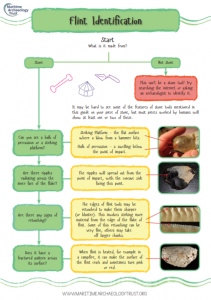This activity is designed to teach pupils about Prehistory and prehistoric flint tools. It is useful to stimulate learning thought practical tasks and observation of their surroundings. It can be completed in a museum, as well as in the classroom. At the Shipwreck Centre and Maritime Museum on the Isle of Wight, for example, pupils can complete the worksheet by handling and analysing historical stone tools.
The worksheet encourages discussions about rock types and how to identify them. It can be used as part of teaching about rocks and their properties, and how to identify them. This activity can be used to help pupils reflect on technological change and the evolution of design. Pupils will be able to reflect on design choices made to meet different needs and how these choices and needs change thought time, determine the production of objects with different features.
The activity can be completed as part of the teaching about Prehistory and to inform students about past civilisations.
Linked files:
Find out more:
Find out more about Archaeological Finds and Recording Methods:
- An educators’ guide, pages 8-9, 12-26-28
- Archaeological Finds
- Archaeology is Rubbish!
- It’s all about context!
- Mystery Wreck
- The Hamble River Activity Book
Click the image below to download the resource!

Curriculum Links
KS2
| SCIENCE | Rocks (page 2) |
| HISOTRY | Ancient civilisations, Methods, Stone Age to Iron Age |
KS3
| ART AND DESIGN | Development (page 1) |
| DESIGN AND TECHNOLOGY | Evaluate (page 1), Design, Evaluate (page 2) |
| GEOGRAPHY | Human geography (page 1) |
| HISTORY | pre-1066 (page 2) |
KS4 and GCSE
| GEOLOGY | Rock types (page 2) |
| DESIGN AND TECHNOLOGY | Principles (page 1) |
